Evaluate Contract Risk and Specialist Requirements for Tender Documentation Report
VerifiedAdded on 2023/05/30
|6
|2047
|270
AI Summary
This assessment task requires students to research the contract risks associated with the compiling of tender documents. It also covers the evaluation of tenders, Australian standards relevant to the tendering process, and the definition of construction industry and principal in the Code of Tendering. The task also includes identifying specialist requirements and practical solutions for the risks associated with them. The output is in JSON format.
Contribute Materials
Your contribution can guide someone’s learning journey. Share your
documents today.
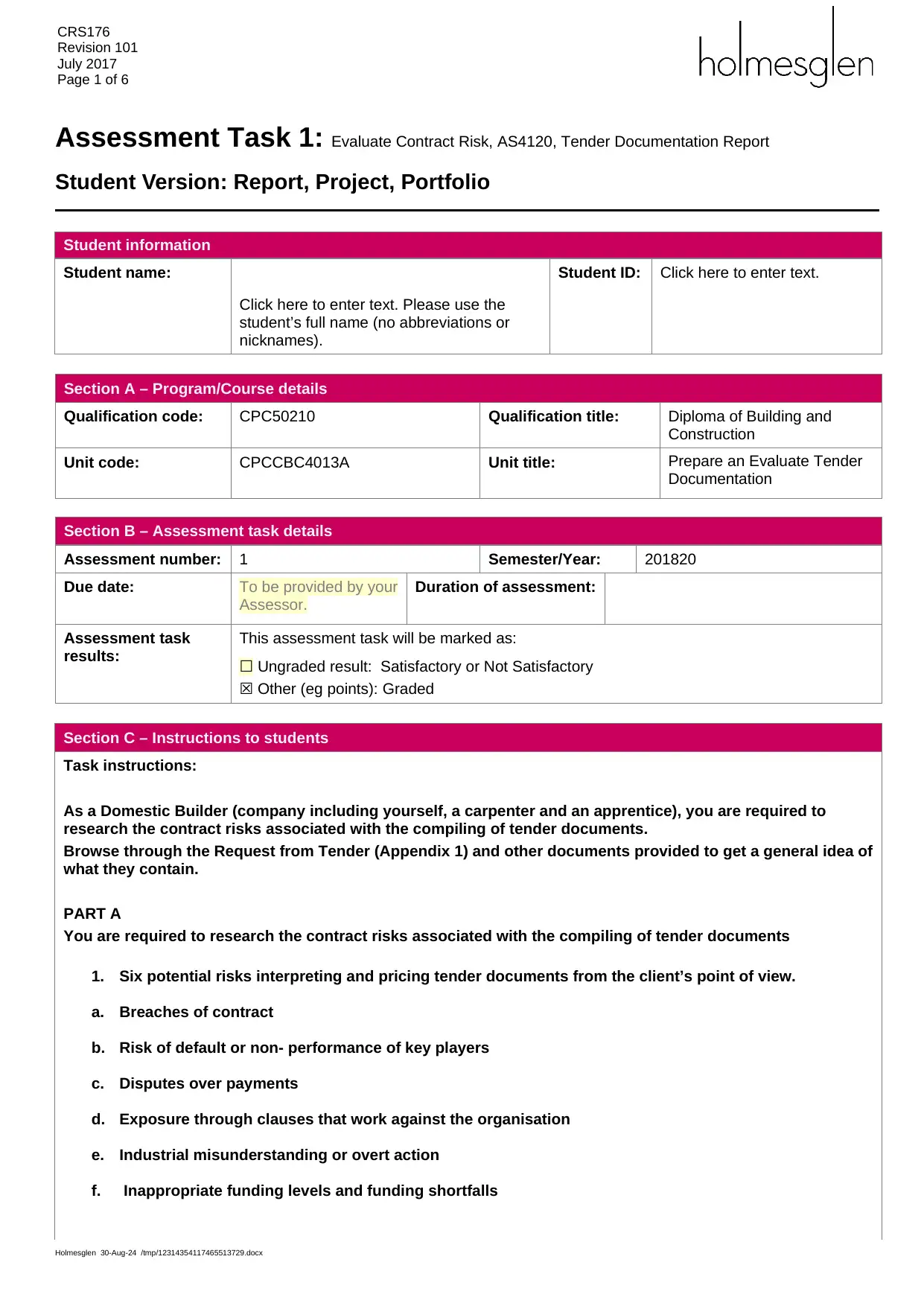
CRS176
Revision 101
July 2017
Page 1 of 6
Assessment Task 1: Evaluate Contract Risk, AS4120, Tender Documentation Report
Student Version: Report, Project, Portfolio
Student information
Student name:
Click here to enter text. Please use the
student’s full name (no abbreviations or
nicknames).
Student ID: Click here to enter text.
Section A – Program/Course details
Qualification code: CPC50210 Qualification title: Diploma of Building and
Construction
Unit code: CPCCBC4013A Unit title: Prepare an Evaluate Tender
Documentation
Section B – Assessment task details
Assessment number: 1 Semester/Year: 201820
Due date: To be provided by your
Assessor.
Duration of assessment:
Assessment task
results:
This assessment task will be marked as:
☐ Ungraded result: Satisfactory or Not Satisfactory
☒ Other (eg points): Graded
Section C – Instructions to students
Task instructions:
As a Domestic Builder (company including yourself, a carpenter and an apprentice), you are required to
research the contract risks associated with the compiling of tender documents.
Browse through the Request from Tender (Appendix 1) and other documents provided to get a general idea of
what they contain.
PART A
You are required to research the contract risks associated with the compiling of tender documents
1. Six potential risks interpreting and pricing tender documents from the client’s point of view.
a. Breaches of contract
b. Risk of default or non- performance of key players
c. Disputes over payments
d. Exposure through clauses that work against the organisation
e. Industrial misunderstanding or overt action
f. Inappropriate funding levels and funding shortfalls
Holmesglen 30-Aug-24 /tmp/12314354117465513729.docx
Revision 101
July 2017
Page 1 of 6
Assessment Task 1: Evaluate Contract Risk, AS4120, Tender Documentation Report
Student Version: Report, Project, Portfolio
Student information
Student name:
Click here to enter text. Please use the
student’s full name (no abbreviations or
nicknames).
Student ID: Click here to enter text.
Section A – Program/Course details
Qualification code: CPC50210 Qualification title: Diploma of Building and
Construction
Unit code: CPCCBC4013A Unit title: Prepare an Evaluate Tender
Documentation
Section B – Assessment task details
Assessment number: 1 Semester/Year: 201820
Due date: To be provided by your
Assessor.
Duration of assessment:
Assessment task
results:
This assessment task will be marked as:
☐ Ungraded result: Satisfactory or Not Satisfactory
☒ Other (eg points): Graded
Section C – Instructions to students
Task instructions:
As a Domestic Builder (company including yourself, a carpenter and an apprentice), you are required to
research the contract risks associated with the compiling of tender documents.
Browse through the Request from Tender (Appendix 1) and other documents provided to get a general idea of
what they contain.
PART A
You are required to research the contract risks associated with the compiling of tender documents
1. Six potential risks interpreting and pricing tender documents from the client’s point of view.
a. Breaches of contract
b. Risk of default or non- performance of key players
c. Disputes over payments
d. Exposure through clauses that work against the organisation
e. Industrial misunderstanding or overt action
f. Inappropriate funding levels and funding shortfalls
Holmesglen 30-Aug-24 /tmp/12314354117465513729.docx
Secure Best Marks with AI Grader
Need help grading? Try our AI Grader for instant feedback on your assignments.
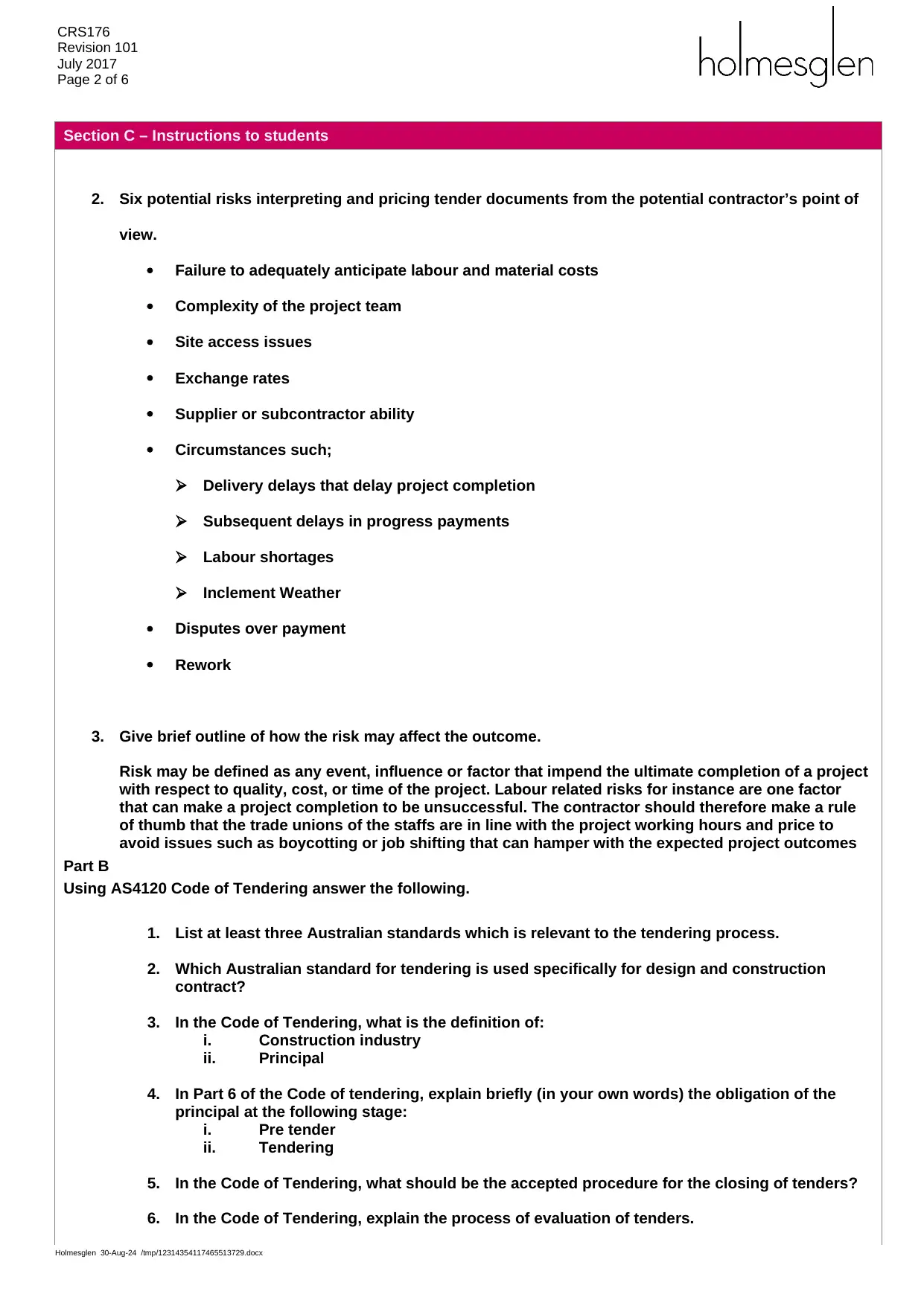
CRS176
Revision 101
July 2017
Page 2 of 6
Section C – Instructions to students
2. Six potential risks interpreting and pricing tender documents from the potential contractor’s point of
view.
Failure to adequately anticipate labour and material costs
Complexity of the project team
Site access issues
Exchange rates
Supplier or subcontractor ability
Circumstances such;
Delivery delays that delay project completion
Subsequent delays in progress payments
Labour shortages
Inclement Weather
Disputes over payment
Rework
3. Give brief outline of how the risk may affect the outcome.
Risk may be defined as any event, influence or factor that impend the ultimate completion of a project
with respect to quality, cost, or time of the project. Labour related risks for instance are one factor
that can make a project completion to be unsuccessful. The contractor should therefore make a rule
of thumb that the trade unions of the staffs are in line with the project working hours and price to
avoid issues such as boycotting or job shifting that can hamper with the expected project outcomes
Part B
Using AS4120 Code of Tendering answer the following.
1. List at least three Australian standards which is relevant to the tendering process.
2. Which Australian standard for tendering is used specifically for design and construction
contract?
3. In the Code of Tendering, what is the definition of:
i. Construction industry
ii. Principal
4. In Part 6 of the Code of tendering, explain briefly (in your own words) the obligation of the
principal at the following stage:
i. Pre tender
ii. Tendering
5. In the Code of Tendering, what should be the accepted procedure for the closing of tenders?
6. In the Code of Tendering, explain the process of evaluation of tenders.
Holmesglen 30-Aug-24 /tmp/12314354117465513729.docx
Revision 101
July 2017
Page 2 of 6
Section C – Instructions to students
2. Six potential risks interpreting and pricing tender documents from the potential contractor’s point of
view.
Failure to adequately anticipate labour and material costs
Complexity of the project team
Site access issues
Exchange rates
Supplier or subcontractor ability
Circumstances such;
Delivery delays that delay project completion
Subsequent delays in progress payments
Labour shortages
Inclement Weather
Disputes over payment
Rework
3. Give brief outline of how the risk may affect the outcome.
Risk may be defined as any event, influence or factor that impend the ultimate completion of a project
with respect to quality, cost, or time of the project. Labour related risks for instance are one factor
that can make a project completion to be unsuccessful. The contractor should therefore make a rule
of thumb that the trade unions of the staffs are in line with the project working hours and price to
avoid issues such as boycotting or job shifting that can hamper with the expected project outcomes
Part B
Using AS4120 Code of Tendering answer the following.
1. List at least three Australian standards which is relevant to the tendering process.
2. Which Australian standard for tendering is used specifically for design and construction
contract?
3. In the Code of Tendering, what is the definition of:
i. Construction industry
ii. Principal
4. In Part 6 of the Code of tendering, explain briefly (in your own words) the obligation of the
principal at the following stage:
i. Pre tender
ii. Tendering
5. In the Code of Tendering, what should be the accepted procedure for the closing of tenders?
6. In the Code of Tendering, explain the process of evaluation of tenders.
Holmesglen 30-Aug-24 /tmp/12314354117465513729.docx
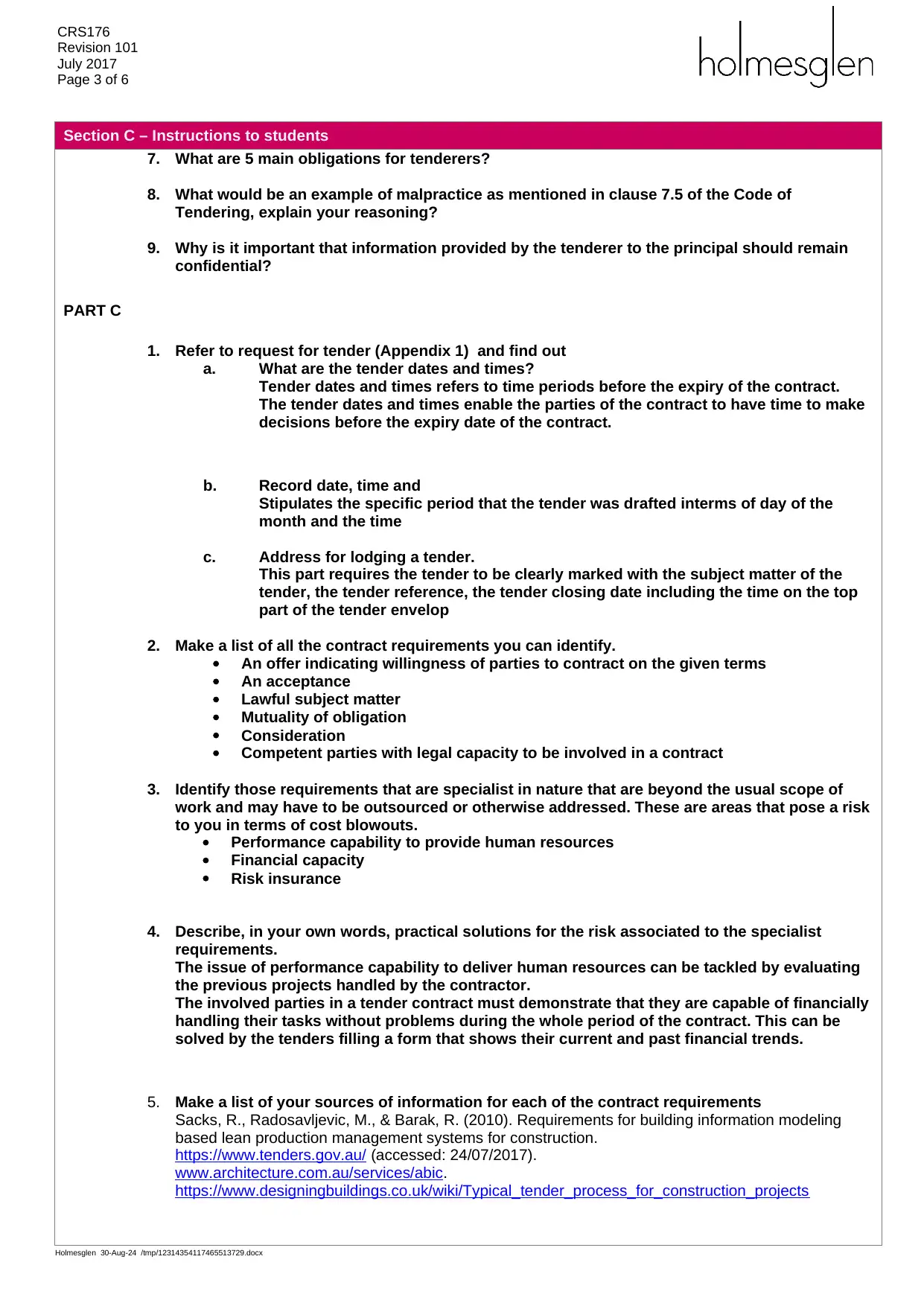
CRS176
Revision 101
July 2017
Page 3 of 6
Section C – Instructions to students
7. What are 5 main obligations for tenderers?
8. What would be an example of malpractice as mentioned in clause 7.5 of the Code of
Tendering, explain your reasoning?
9. Why is it important that information provided by the tenderer to the principal should remain
confidential?
PART C
1. Refer to request for tender (Appendix 1) and find out
a. What are the tender dates and times?
Tender dates and times refers to time periods before the expiry of the contract.
The tender dates and times enable the parties of the contract to have time to make
decisions before the expiry date of the contract.
b. Record date, time and
Stipulates the specific period that the tender was drafted interms of day of the
month and the time
c. Address for lodging a tender.
This part requires the tender to be clearly marked with the subject matter of the
tender, the tender reference, the tender closing date including the time on the top
part of the tender envelop
2. Make a list of all the contract requirements you can identify.
An offer indicating willingness of parties to contract on the given terms
An acceptance
Lawful subject matter
Mutuality of obligation
Consideration
Competent parties with legal capacity to be involved in a contract
3. Identify those requirements that are specialist in nature that are beyond the usual scope of
work and may have to be outsourced or otherwise addressed. These are areas that pose a risk
to you in terms of cost blowouts.
Performance capability to provide human resources
Financial capacity
Risk insurance
4. Describe, in your own words, practical solutions for the risk associated to the specialist
requirements.
The issue of performance capability to deliver human resources can be tackled by evaluating
the previous projects handled by the contractor.
The involved parties in a tender contract must demonstrate that they are capable of financially
handling their tasks without problems during the whole period of the contract. This can be
solved by the tenders filling a form that shows their current and past financial trends.
5. Make a list of your sources of information for each of the contract requirements
Sacks, R., Radosavljevic, M., & Barak, R. (2010). Requirements for building information modeling
based lean production management systems for construction.
https://www.tenders.gov.au/ (accessed: 24/07/2017).
www.architecture.com.au/services/abic.
https://www.designingbuildings.co.uk/wiki/Typical_tender_process_for_construction_projects
Holmesglen 30-Aug-24 /tmp/12314354117465513729.docx
Revision 101
July 2017
Page 3 of 6
Section C – Instructions to students
7. What are 5 main obligations for tenderers?
8. What would be an example of malpractice as mentioned in clause 7.5 of the Code of
Tendering, explain your reasoning?
9. Why is it important that information provided by the tenderer to the principal should remain
confidential?
PART C
1. Refer to request for tender (Appendix 1) and find out
a. What are the tender dates and times?
Tender dates and times refers to time periods before the expiry of the contract.
The tender dates and times enable the parties of the contract to have time to make
decisions before the expiry date of the contract.
b. Record date, time and
Stipulates the specific period that the tender was drafted interms of day of the
month and the time
c. Address for lodging a tender.
This part requires the tender to be clearly marked with the subject matter of the
tender, the tender reference, the tender closing date including the time on the top
part of the tender envelop
2. Make a list of all the contract requirements you can identify.
An offer indicating willingness of parties to contract on the given terms
An acceptance
Lawful subject matter
Mutuality of obligation
Consideration
Competent parties with legal capacity to be involved in a contract
3. Identify those requirements that are specialist in nature that are beyond the usual scope of
work and may have to be outsourced or otherwise addressed. These are areas that pose a risk
to you in terms of cost blowouts.
Performance capability to provide human resources
Financial capacity
Risk insurance
4. Describe, in your own words, practical solutions for the risk associated to the specialist
requirements.
The issue of performance capability to deliver human resources can be tackled by evaluating
the previous projects handled by the contractor.
The involved parties in a tender contract must demonstrate that they are capable of financially
handling their tasks without problems during the whole period of the contract. This can be
solved by the tenders filling a form that shows their current and past financial trends.
5. Make a list of your sources of information for each of the contract requirements
Sacks, R., Radosavljevic, M., & Barak, R. (2010). Requirements for building information modeling
based lean production management systems for construction.
https://www.tenders.gov.au/ (accessed: 24/07/2017).
www.architecture.com.au/services/abic.
https://www.designingbuildings.co.uk/wiki/Typical_tender_process_for_construction_projects
Holmesglen 30-Aug-24 /tmp/12314354117465513729.docx
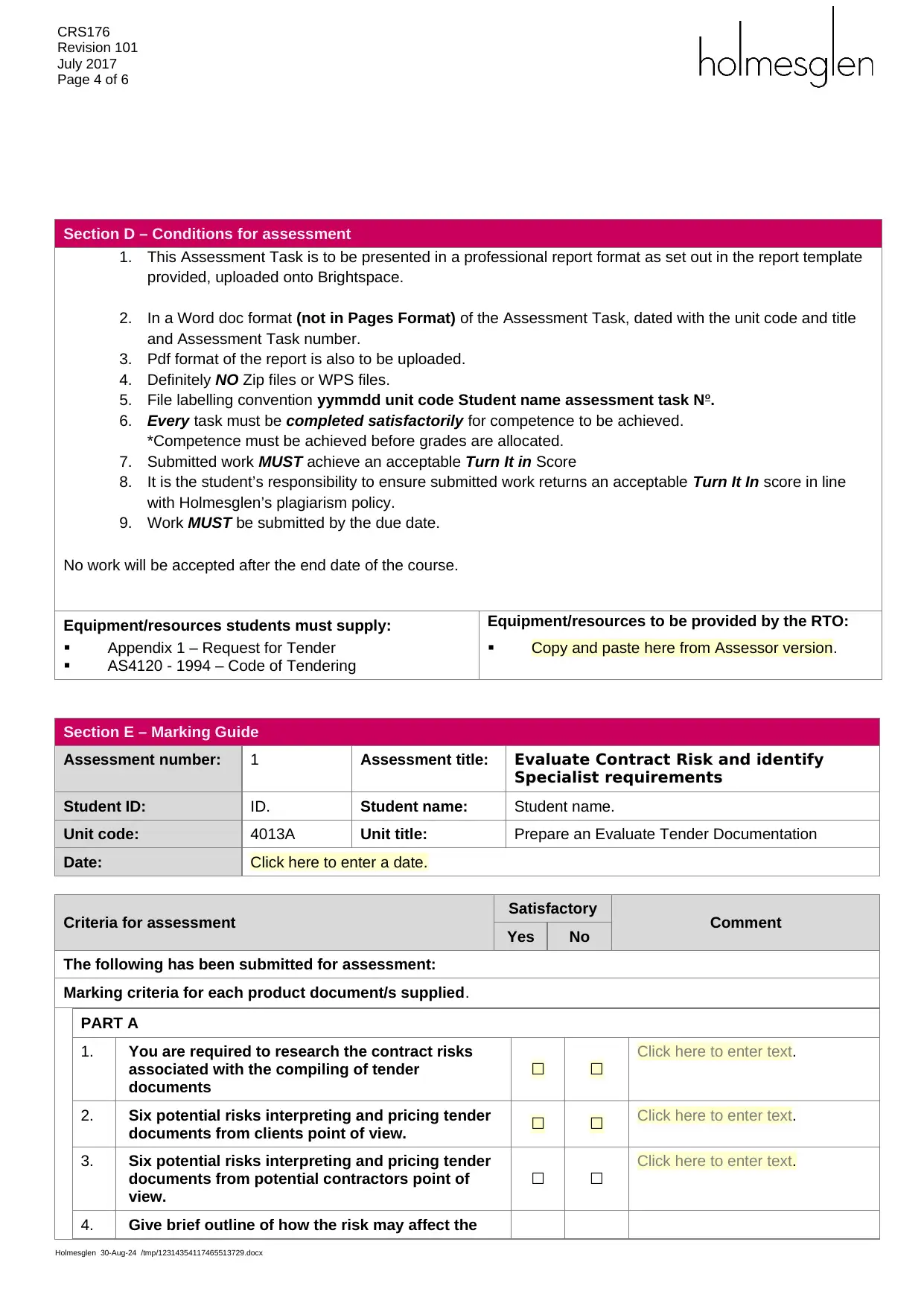
CRS176
Revision 101
July 2017
Page 4 of 6
Section D – Conditions for assessment
1. This Assessment Task is to be presented in a professional report format as set out in the report template
provided, uploaded onto Brightspace.
2. In a Word doc format (not in Pages Format) of the Assessment Task, dated with the unit code and title
and Assessment Task number.
3. Pdf format of the report is also to be uploaded.
4. Definitely NO Zip files or WPS files.
5. File labelling convention yymmdd unit code Student name assessment task No.
6. Every task must be completed satisfactorily for competence to be achieved.
*Competence must be achieved before grades are allocated.
7. Submitted work MUST achieve an acceptable Turn It in Score
8. It is the student’s responsibility to ensure submitted work returns an acceptable Turn It In score in line
with Holmesglen’s plagiarism policy.
9. Work MUST be submitted by the due date.
No work will be accepted after the end date of the course.
Equipment/resources students must supply: Equipment/resources to be provided by the RTO:
Appendix 1 – Request for Tender
AS4120 - 1994 – Code of Tendering
Copy and paste here from Assessor version.
Section E – Marking Guide
Assessment number: 1 Assessment title: Evaluate Contract Risk and identify
Specialist requirements
Student ID: ID. Student name: Student name.
Unit code: 4013A Unit title: Prepare an Evaluate Tender Documentation
Date: Click here to enter a date.
Criteria for assessment Satisfactory Comment
Yes No
The following has been submitted for assessment:
Marking criteria for each product document/s supplied.
PART A
1. You are required to research the contract risks
associated with the compiling of tender
documents
☐ ☐
Click here to enter text.
2. Six potential risks interpreting and pricing tender
documents from clients point of view. ☐ ☐ Click here to enter text.
3. Six potential risks interpreting and pricing tender
documents from potential contractors point of
view.
☐ ☐
Click here to enter text.
4. Give brief outline of how the risk may affect the
Holmesglen 30-Aug-24 /tmp/12314354117465513729.docx
Revision 101
July 2017
Page 4 of 6
Section D – Conditions for assessment
1. This Assessment Task is to be presented in a professional report format as set out in the report template
provided, uploaded onto Brightspace.
2. In a Word doc format (not in Pages Format) of the Assessment Task, dated with the unit code and title
and Assessment Task number.
3. Pdf format of the report is also to be uploaded.
4. Definitely NO Zip files or WPS files.
5. File labelling convention yymmdd unit code Student name assessment task No.
6. Every task must be completed satisfactorily for competence to be achieved.
*Competence must be achieved before grades are allocated.
7. Submitted work MUST achieve an acceptable Turn It in Score
8. It is the student’s responsibility to ensure submitted work returns an acceptable Turn It In score in line
with Holmesglen’s plagiarism policy.
9. Work MUST be submitted by the due date.
No work will be accepted after the end date of the course.
Equipment/resources students must supply: Equipment/resources to be provided by the RTO:
Appendix 1 – Request for Tender
AS4120 - 1994 – Code of Tendering
Copy and paste here from Assessor version.
Section E – Marking Guide
Assessment number: 1 Assessment title: Evaluate Contract Risk and identify
Specialist requirements
Student ID: ID. Student name: Student name.
Unit code: 4013A Unit title: Prepare an Evaluate Tender Documentation
Date: Click here to enter a date.
Criteria for assessment Satisfactory Comment
Yes No
The following has been submitted for assessment:
Marking criteria for each product document/s supplied.
PART A
1. You are required to research the contract risks
associated with the compiling of tender
documents
☐ ☐
Click here to enter text.
2. Six potential risks interpreting and pricing tender
documents from clients point of view. ☐ ☐ Click here to enter text.
3. Six potential risks interpreting and pricing tender
documents from potential contractors point of
view.
☐ ☐
Click here to enter text.
4. Give brief outline of how the risk may affect the
Holmesglen 30-Aug-24 /tmp/12314354117465513729.docx
Secure Best Marks with AI Grader
Need help grading? Try our AI Grader for instant feedback on your assignments.
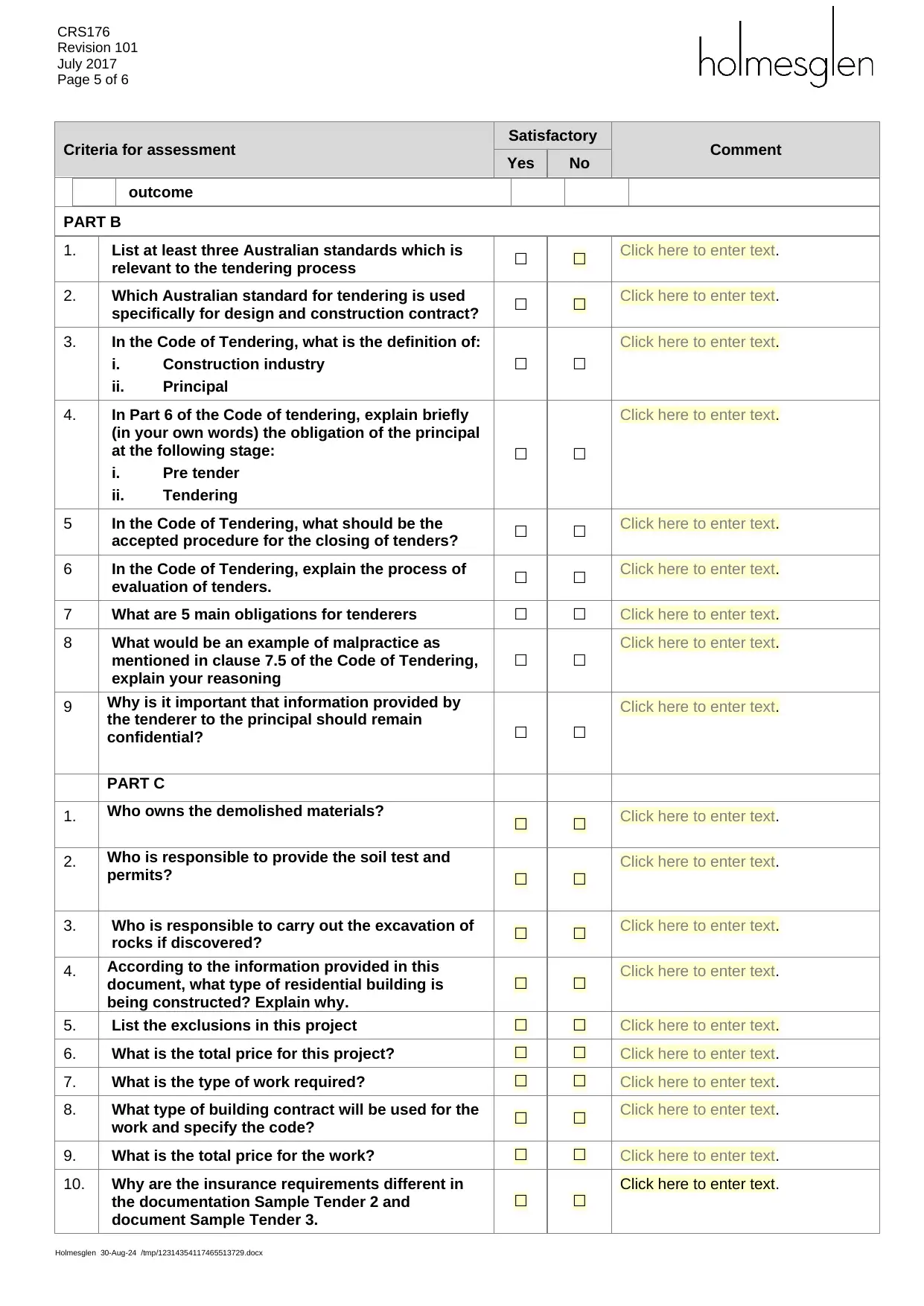
CRS176
Revision 101
July 2017
Page 5 of 6
Criteria for assessment Satisfactory Comment
Yes No
outcome
PART B
1. List at least three Australian standards which is
relevant to the tendering process ☐ ☐ Click here to enter text.
2. Which Australian standard for tendering is used
specifically for design and construction contract? ☐ ☐ Click here to enter text.
3. In the Code of Tendering, what is the definition of:
i. Construction industry
ii. Principal
☐ ☐
Click here to enter text.
4. In Part 6 of the Code of tendering, explain briefly
(in your own words) the obligation of the principal
at the following stage:
i. Pre tender
ii. Tendering
☐ ☐
Click here to enter text.
5 In the Code of Tendering, what should be the
accepted procedure for the closing of tenders? ☐ ☐ Click here to enter text.
6 In the Code of Tendering, explain the process of
evaluation of tenders. ☐ ☐ Click here to enter text.
7 What are 5 main obligations for tenderers ☐ ☐ Click here to enter text.
8 What would be an example of malpractice as
mentioned in clause 7.5 of the Code of Tendering,
explain your reasoning
☐ ☐
Click here to enter text.
9 Why is it important that information provided by
the tenderer to the principal should remain
confidential? ☐ ☐
Click here to enter text.
PART C
1. Who owns the demolished materials? ☐ ☐ Click here to enter text.
2. Who is responsible to provide the soil test and
permits? ☐ ☐
Click here to enter text.
3. Who is responsible to carry out the excavation of
rocks if discovered? ☐ ☐ Click here to enter text.
4. According to the information provided in this
document, what type of residential building is
being constructed? Explain why.
☐ ☐ Click here to enter text.
5. List the exclusions in this project ☐ ☐ Click here to enter text.
6. What is the total price for this project? ☐ ☐ Click here to enter text.
7. What is the type of work required? ☐ ☐ Click here to enter text.
8. What type of building contract will be used for the
work and specify the code? ☐ ☐ Click here to enter text.
9. What is the total price for the work? ☐ ☐ Click here to enter text.
10. Why are the insurance requirements different in
the documentation Sample Tender 2 and
document Sample Tender 3.
☐ ☐
Click here to enter text.
Holmesglen 30-Aug-24 /tmp/12314354117465513729.docx
Revision 101
July 2017
Page 5 of 6
Criteria for assessment Satisfactory Comment
Yes No
outcome
PART B
1. List at least three Australian standards which is
relevant to the tendering process ☐ ☐ Click here to enter text.
2. Which Australian standard for tendering is used
specifically for design and construction contract? ☐ ☐ Click here to enter text.
3. In the Code of Tendering, what is the definition of:
i. Construction industry
ii. Principal
☐ ☐
Click here to enter text.
4. In Part 6 of the Code of tendering, explain briefly
(in your own words) the obligation of the principal
at the following stage:
i. Pre tender
ii. Tendering
☐ ☐
Click here to enter text.
5 In the Code of Tendering, what should be the
accepted procedure for the closing of tenders? ☐ ☐ Click here to enter text.
6 In the Code of Tendering, explain the process of
evaluation of tenders. ☐ ☐ Click here to enter text.
7 What are 5 main obligations for tenderers ☐ ☐ Click here to enter text.
8 What would be an example of malpractice as
mentioned in clause 7.5 of the Code of Tendering,
explain your reasoning
☐ ☐
Click here to enter text.
9 Why is it important that information provided by
the tenderer to the principal should remain
confidential? ☐ ☐
Click here to enter text.
PART C
1. Who owns the demolished materials? ☐ ☐ Click here to enter text.
2. Who is responsible to provide the soil test and
permits? ☐ ☐
Click here to enter text.
3. Who is responsible to carry out the excavation of
rocks if discovered? ☐ ☐ Click here to enter text.
4. According to the information provided in this
document, what type of residential building is
being constructed? Explain why.
☐ ☐ Click here to enter text.
5. List the exclusions in this project ☐ ☐ Click here to enter text.
6. What is the total price for this project? ☐ ☐ Click here to enter text.
7. What is the type of work required? ☐ ☐ Click here to enter text.
8. What type of building contract will be used for the
work and specify the code? ☐ ☐ Click here to enter text.
9. What is the total price for the work? ☐ ☐ Click here to enter text.
10. Why are the insurance requirements different in
the documentation Sample Tender 2 and
document Sample Tender 3.
☐ ☐
Click here to enter text.
Holmesglen 30-Aug-24 /tmp/12314354117465513729.docx
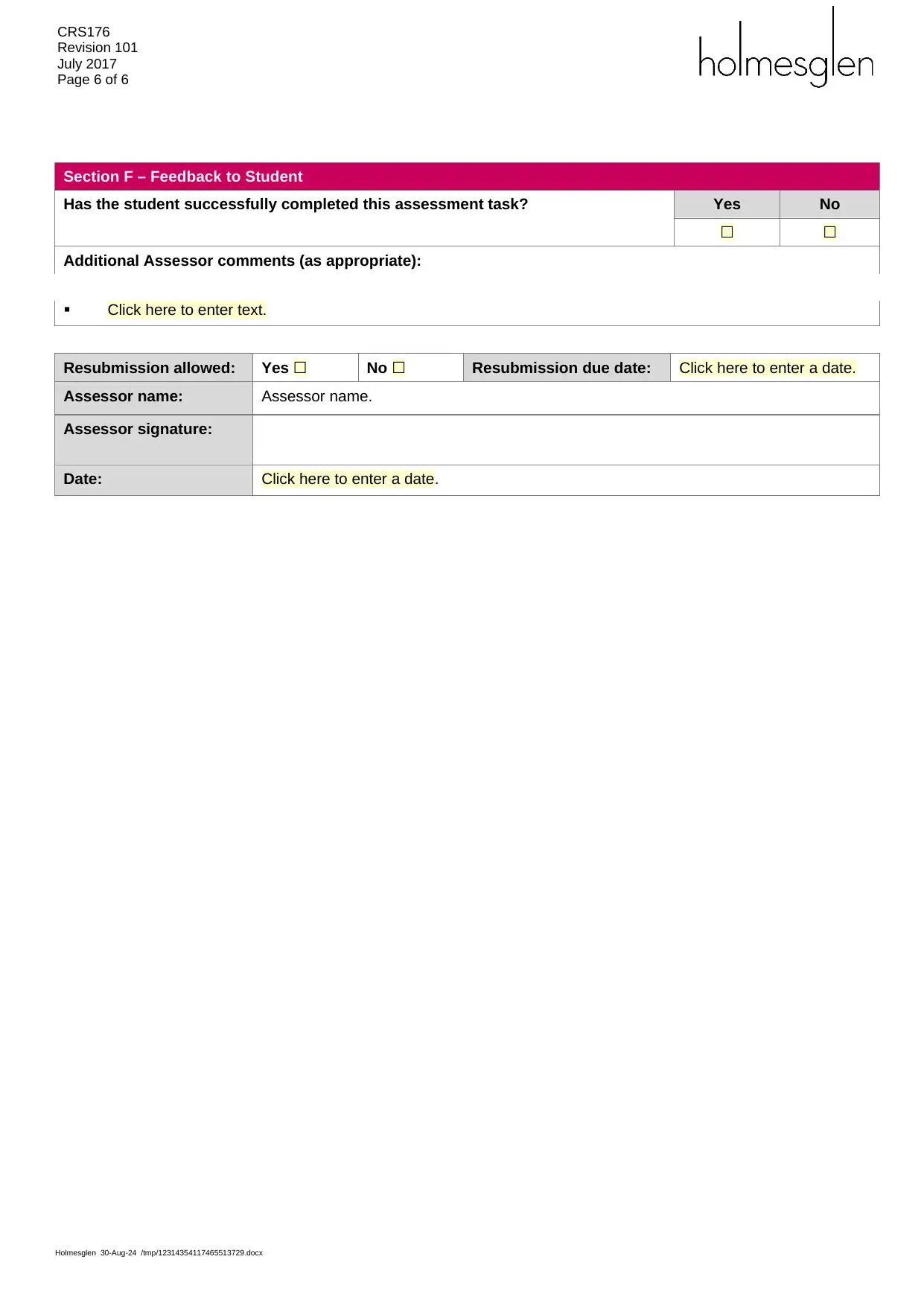
CRS176
Revision 101
July 2017
Page 6 of 6
Section F – Feedback to Student
Has the student successfully completed this assessment task? Yes No
☐ ☐
Additional Assessor comments (as appropriate):
Click here to enter text.
Resubmission allowed: Yes ☐ No ☐ Resubmission due date: Click here to enter a date.
Assessor name: Assessor name.
Assessor signature:
Date: Click here to enter a date.
Holmesglen 30-Aug-24 /tmp/12314354117465513729.docx
Revision 101
July 2017
Page 6 of 6
Section F – Feedback to Student
Has the student successfully completed this assessment task? Yes No
☐ ☐
Additional Assessor comments (as appropriate):
Click here to enter text.
Resubmission allowed: Yes ☐ No ☐ Resubmission due date: Click here to enter a date.
Assessor name: Assessor name.
Assessor signature:
Date: Click here to enter a date.
Holmesglen 30-Aug-24 /tmp/12314354117465513729.docx
1 out of 6
Related Documents
Your All-in-One AI-Powered Toolkit for Academic Success.
+13062052269
info@desklib.com
Available 24*7 on WhatsApp / Email
![[object Object]](/_next/static/media/star-bottom.7253800d.svg)
Unlock your academic potential
© 2024 | Zucol Services PVT LTD | All rights reserved.





